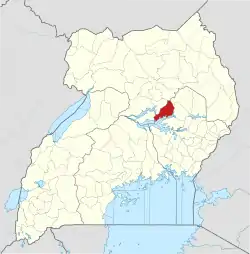Kaberamaido District
Kaberamaido is a district in Eastern Uganda. Like most other Ugandan districts, it is named after its 'chief town', Kaberamaido, where the district headquarters are located.
Kaberamaido District | |
|---|---|
 District location in Uganda | |
| Coordinates: 01°47′N 33°09′E | |
| Country | |
| Region | Eastern Uganda |
| Sub-region | Teso sub-region |
| Capital | Kaberamaido |
| Area | |
| • Total | 1,788.5 km2 (690.5 sq mi) |
| • Land | 1,354.5 km2 (523.0 sq mi) |
| • Water | 434 km2 (168 sq mi) |
| Elevation | 1,080 m (3,540 ft) |
| Population (2012 Estimate) | |
| • Total | 199,200 |
| • Density | 147.1/km2 (381/sq mi) |
| Time zone | UTC+3 (EAT) |
| Website | www |
Location
Kaberamaido District lies approximately between Latitudes:1.5500 to 2.3834 and Longitudes:30.0167 to 34.3000. The average coordinates of the district are:01 47N, 33 09E. The district is bordered by Alebtong District to the north, Amuria District to the northeast, Soroti District to the east, Serere District to the southeast, Buyende District to the south, Amolatar District to the southwest and Dokolo District to the northwest.[1] The District headquarters at Kaberamaido, lie approximately 65 kilometres (40 mi) by road, west of Soroti, the largest city in the sub-region.[2] This location lies approximately 215 kilometres (134 mi), by road, northeast of Kampala, the capital of Uganda and the largest city in that country.[3]
Physical measurements
The following are the district measurements:
- Total Area : 1,788.5 square kilometres (690.5 sq mi)
- Total Land Area : 1,354.5 square kilometres (523.0 sq mi) (75.7%)
- Forest Area : 22 square kilometres (8.5 sq mi) (1.3%)
- Open Water Area : 269 square kilometres (104 sq mi) (16.4%)
- Area Under Wetlands : 143 square kilometres (55 sq mi) (8.7%)
Population
In 1991, the national population census estimated the population of the district at about 81,500. The district had a population of approximately 131,700 in 2002, according to the national census that year, with an annual population growth rate of 4.3%. In 2012, it was estimated that the population of Kaberamaido District was approximately 199,200.[4] The table below, illustrates how the district has grown between 2002 and 2012. All numbers are estimates.
|
|
|
Ethnicities
Kaberamaido District is part of Teso sub-region and is the main area of the Kumam people. In 2008, the Kumam were in the majority, totaling 99,738 (74.7%) of the population. The Iteso were the next most populous group in the district, totaling 27,317 people (20.5%). These two ethnicities respectively, speak Kumam and Ateso languages and are of the Nilotic family. The Langi at 4,617 people (3.5%) are the next most populous group. The other tribal groups found in the district constitute less than 1% of the district population in individual tribal terms. These include, the Acholi, Bagwere, Bakenyi, Baruli, Mening, Basoga, Baganda and Alur.
See also
References
- Uganda District Map
- "Map Showing Soroti And Kaberamaido With Distance Marker". Globefeed.com. Retrieved 18 May 2014.
- "Distance Between Kampala And Kaberamaido With Map". Citypopulation.de. Retrieved 18 May 2014.
- "Estimated Population of Kaberamaido District In 1991, 2002 & 2012". Citypopulation.de. Retrieved 18 May 2014.